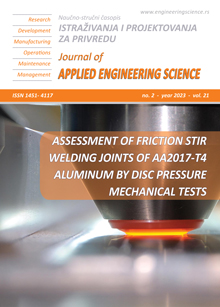DEVELOPMENT DYNAMIC COMPLIANCE COST MODEL FOR IMPLEMENTATION OF BALLAST WATER MANAGEMENT CONVENTION: SHIPOWNER PERSPECTIVE
Abstract
The Ballast Water Management Convention (BWMC) regulates ship ballast water management to avoid the spread of aquatic invasive species. The convention requires all ships, including existing ones, to have a Ballast Water Treatment System (BWTS) onboard before September 8, 2024. There are some concerns about the compliance costs of BWMC, especially the additional cost of retrofitting cases. The ship retrofitting cost will depend on various factors, and it can be difficult for a shipowner to determine accurately. The procedure is intricate, and there are many factors to consider, such as the ship's size, BWTS system complexity, and the price of materials and modification level. In this paper, A proposed approach involves expert judgment to capture the effect of multi-stakeholder and estimate the compliance cost. As an essential part of the research methodology, the system dynamics method and life cycle cost are combined to develop a compliance cost model during the ship's lifetime. The simulation model shows that the confidence level of retrofitting costs for each BWTS is more than 94%. Therefore, the model can be used to estimate additional costs. As a result, BWTS type A is the most economical system for small tankers, with an estimated cost of USD 802,860 for the remaining 12 years of the ship's lifetime. Shipowners can use this model as a supporting decision tool to determine which BWTS would be suitable and assist in determining the budget necessary to comply with the BWMC.
References
style='mso-bookmark:_Hlk126904011'>
style='mso-bookmark:_Hlk126904011'>
style='mso-spacerun:yes'> ADDIN ZOTERO_BIBL
{"uncited":[],"omitted":[],"custom":[]}
CSL_BIBLIOGRAPHY IMO. (2004). International Convention for the Control and Management of Ships' Ballast Water and Sediments. International Maritime Organization, from http://www.imo.org.>
Bailey, S. A., Brydges, T., Casas-Monroy, O., Kydd, J., Linley, R. D., Rozon, R. M., & Darling, J. A. (2022). First evaluation of ballast water management systems on operational ships for minimizing introductions of nonindigenous zooplankton. Marine Pollution Bulletin. DOI://doi.org/10.1016/j.marpolbul.2022.113947
IMO. (2009). Ballast Water Management Convention and the Guidelines for Its Implementation. United Kingdom. International Maritime Organization.
Campara, L., Francic, V., Maglic, L., & Hasanspahic, N. (2019). Overview and comparison of the IMO and the US Maritime Administration ballast water management regulations. Journal of Marine Science and Engineering. DOI://doi.org/10.3390/jmse7090283
Wang, Z., & Corbett, J. (2021). Scenario-based cost-effectiveness analysis of ballast water treatment strategies. Management of Biological Invasions. DOI://doi.org/10.3391/mbi.2021.12.1.08
Wang, Z., Nong, D., Countryman, A. M., Corbett, J. J., & Warziniack, T. (2020). Potential impacts of ballast water regulations on international trade, shipping patterns, and the global economy: An integrated transportation and economic modeling assessment. Journal of Environmental Management. DOI://doi.org/10.1016/j.jenvman.2020.110892
IMO., GloBallast, P. P. (2010). Economic Assessments for Ballast Water Management: A Guideline. GEF-UNDP-IMO GloBallast Partnerships. London. GloBallast Monographs No. 19
ABS. (2019). Ballast Water Management Advisory 2019. American Bureau of Shipping. from https://ww2.eagle.org/content/dam/eagle/publications/reference-report/2019-bwms-best-practices.pdf)>
Bradie, J., Broeg, K., Gianoli, C., He, J., Heitmüller, S., Curto, A. L., Bailey, S. (2018). A shipboard comparison of analytic methods for ballast water compliance monitoring. Journal of Sea Research. DOI://doi.org/10.1016/j.seares.2017.01.006
Kalniņa, R., & Romule, A. (2020). Analysis of Ballast Water Treatment Technologies on Ships Operating in the Baltic Sea Region. Transport and Aerospace Engineering. DOI://doi.org/10.2478/tae-2020-0002
Kontovas, C. A. (2019). The market and economics of mobile port-based Ballast Water Treatment solutions. Proceedings of International Association of Maritime Economists (IAME) Conference. Athens, Greece. from http://researchonline.ljmu.ac.uk/id/eprint/11726/>
Ishola, A., & Kontovas, C. A. (2022). Managing Ship’s Ballast Water: A Feasibility Assessment of Mobile Port-Based Treatment. Sustainability. DOI://doi.org/10.3390/su142214824
Tjahjono, A., & Handoko, W. (2018). The implementation of ballast water management in Port of Tanjung Emas semarang: Strategy and model. AACL Bioflux, vol.11(4), p.1231–1247.
Wang, Z., & Corbett, J. J. (2020). Scenario-based cost-effectiveness analysis of ballast water treatment strategies. Management of Biological Invasions. DOI://doi.org/10.3391/mbi.2021.12.1.08
Sèbe, M., Kontovas, C., A., & Pendleton, L. (2019). A decision-making framework to reduce the risk of collisions between ships and whales. Marine Policy.. DOI:doi.org/10.1016/j.marpol.2019.103697
Bui, K. Q., Perera, L. P., & Emblemsvåg, J. (2021). Development of a life-cycle cost framework for retrofitting marine engines towards emission reduction in shipping. IFAC-PapersOnLine. DOI://doi.org/10.1016/j.ifacol.2021.10.091
Blanco-Davis, E., & Zhou, P. (2014). LCA as a tool to aid in the selection of retrofitting alternatives. Ocean Engineering. DOI://doi.org/10.1016/J.OCEANENG.2013.12.010
Sterman, J. D. (2002). Systems Thinking and Modeling for a Complex World. Interfaces (Vol. 34). Boston: Irwin McGraw-Hill. from http://www.lavoisier.fr/notice/frJWOAR6SA23WLOO.html>
McAvoy, S., Grant, T., Smith, C., & Bontinck, P. (2021). Combining Life Cycle Assessment and System Dynamics to improve impact assessment: A systematic review. Journal of Cleaner Production. https://doi.org/10.1016/J.JCLEPRO.2021.128060>
Jovanovski, B., Minovski, R., Voessner, S., & Lichtenegger, G. (2012). Combining system dynamics and discrete event simulations - Overview of hybrid simulation models. Journal of Applied Engineering Science. DOI://doi.org/10.5937/jaes10-2512
Lou, N., & Guo, J. (2020). Study on Key Cost Drivers of Prefabricated Buildings Based on System Dynamics. Advances in Civil Engineering. DOI://doi.org/10.1155/2020/8896435
Hardiyanto, Pitana, T., & Handani, D. W. (2020). The Impact of Implementation New Regulation on Maritime Industry: A Review of Implementation BWTS. In IOP Conference Series: Earth and Environmental Science (Vol. 557, p. 10). DOI://doi.org/10.1088/1755-1315/557/1/012058
Rebs, T., Brandenburg, M., & Seuring, S. (2019). System dynamics modeling for sustainable supply chain management: A literature review and systems thinking approach. Journal of Cleaner Production. DOI://doi.org/10.1016/j.jclepro.2018.10.100
ISO 15686-5. (2008). Building and constructed assets - Service-life planning - Part 5: Life-cycle costing. Geneve, Switzerland. International Organization for Standardization.
Bui, K. Q., Perera, L. P., & Emblemsvåg, J. (2022). Life-cycle cost analysis of an innovative marine dual-fuel engine under uncertainties. Journal of Cleaner Production. DOI://doi.org/10.1016/J.JCLEPRO.2022.134847
King, D., Hagan, P., Riggio, M., & Wright, D. (2012). Preview of global ballast water treatment markets. Journal of Marine Engineering & Technology. DOI://doi.org/10.1080/20464177.2012.11020256
ABS. (2019). Best Practices for Operations of Ballast Water Management Systems Report. American Bureau of Shipping. from https://ww2.eagle.org/content/dam/eagle/publications/reference-report/Marine_BWM_Best_Practices_Report.pdf>
Gerhard, W. A., Lundgreen, K., Drillet, G., Baumler, R., Holbech, H., & Gunsch, C. K. (2019). Installation and use of ballast water treatment systems – Implications for compliance and enforcement. Ocean & Coastal Management. DOI://doi.org/10.1016/j.ocecoaman.2019.104907
lang=EN-US style='font-size:10.0pt;font-family:"Arial",sans-serif;mso-fareast-font-family:
"Times New Roman";mso-bidi-font-family:"Times New Roman";mso-ansi-language:
EN-US;mso-fareast-language:EN-US;mso-bidi-language:AR-SA'>
style='mso-element:field-end'>
lang=EN-US>

